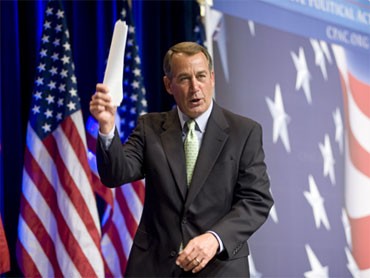The “movie of the moment” during a wasteland of pre-summer cinema, Harmony Korine’s Spring Breakers beckons viewers who, like the film’s four bored coed protagonists, long to see something different.
Spring Breakers is a stunt movie of the highest order, enabling a cast full of Disney and ABC Family types — Pretty Little Liars‘ Ashley Benson, High School Musical‘s Vanessa Hudgens, and pop princess Selena Gomez — to play hard against type, down-for-anything James Franco to don corn rows and a platinum grill, and longtime provocateur Korine (still best known for scripting Kids in the mid-’90s) to improbably land what’s essentially an art-house “girls gone wild” video into suburban multiplexes.
The film opens with a sun-kissed, color-drenched, spring-break blowout of beer and boobs — girls fellating Bomb Pops, guys pretending to “urinate” beer into the waiting mouths of young women, and other displays of drunken depravity. It basically makes every moment of “spring break” look like the back end of an R-rated “Harlem Shake” video. Is this a college kid’s dream, a parent’s nightmare, or a filmmaker’s voyeuristic fantasy?
Or maybe it’s the fantasy of Candy (Hudgens), Brit (Benson), Cotty (Rachel Korine, the filmmaker’s wife), and Faith (Gomez), who are stuck on a college campus where the sun apparently never shines, too broke to be Florida-bound with their classmates.
Unbeknownst to church-group attendee Faith, the other three hatch a plan to raise vacation funds using ski masks, hammers, and a squirt gun — “We robbed the chicken shack,” they explain afterward — and soon they’re headed south, where things get wetter and wilder, at least until they end up in court (in bikinis, natch), are bailed out by gangster/rapper Alien (Franco, the potential Big Bad Wolf of this fairy tale), and something more plot-driven and (even more) self-consciously ridiculous emerges.
Stylistically, much of the film plays like a hazy, over-extended montage — stretching to reach 94 minutes — evoking, alternately, frat-house cell-phone captures and fantastical rap videos but goosed even more toward the absurd. (Or maybe not. Maybe bros really do put raw turkeys on their heads at keggers. What do I know?)
The film’s setting is utterly contemporary, but as a work of art it reveals the 40-year-old Korine’s ’80s youth as much as the VHS worship of the prior Trash Humpers did. Here, Korine weaves the fun-in-the-sun sexploitation cheapies (Hardbodies, Spring Break) that dotted Reagan-era HBO with the scuzzy drugs-and-guns Florida action of the name-checked Scarface and the implied Miami Vice.
Like most of its subjects, this over-crafted exploitation flick is ripe, alluring, and self-consciously daring, but I wonder if it has much on the brain. Spring Breakers nods toward social criticism, skipping knowingly along the thin line that separates camp from cautionary tale.
But its perspective is hard to read, and the critical elements of the film seem mostly designed to assist viewers in rationalizing the film’s more pervy pleasures. Korine’s fevered depiction of spring-break depravity definitely carries a whiff of satire and disapproval. There’s a (David) Lynchian bent to the way Korine juxtaposes a voiceover of Faith reading an earnest letter home (“Hi Grandma. This is the most spiritual place I’ve ever been. Everyone’s so warm and friendly here”) with a beer-bong bacchanalia. But this strain of commentary doesn’t keep Korine’s camera — which locates copious crotch close-ups — from ogling. Here, arty and sardonic touches help make the leering feel justifiable.
I’m not sure what to make of this ostensibly Southern film’s strained, half-knowing take on African-Americans and their history. This (at first accidental?) motif starts early, when Candy and Brit sit in a lecture hall, learning about Emmett Till while day-dreaming of spring-break sex, and maybe it’s that subtle bit of info that made me hear the later repetition of the phrase “four little girls,” in reference to the film’s core foursome, in civil rights terms. (It’s the name of Spike Lee’s documentary about the Birmingham church bombing.) This friction becomes more direct in the film’s final act, when rapper Gucci Mane appears as a particularly stereotypical gangbanger and Gomez’s Faith decides to bounce after being brought to a pool hall in a black neighborhood. After all she’s been through, this is her bridge too far. (“We don’t know these people,” she explains, as if the beach full of mostly white date-rape threats she’d been partying with were all old pals.) It’s unclear whether Korine is commenting on racial discomfort or displaying it.
As for its daring, it’s predictable that the biggest star of the foursome, Gomez, plays the Good Girl, while the one with the least at stake (Rachel Korine) is the one whose body is subjected to the most graphic exposure.
Mostly, I just wish the filmmaking itself were as bracing as the lurid, lollipop subject matter — its nighttime bikini scooter rides, its ski-masked beach-bunny crime spree, its squirt-gun conflation of oral sex and suicide.
Korine is capable. His debut, Gummo, dug beyond its small-town grotesquerie surface into realms of real beauty and, at times, the VHS aesthetic of the underground provocation Trash Humpers is legitimately unnerving. Spring Breakers has its moments, especially in the tracking-shot depiction of the early robbery, seen from the perspective of a slow-rolling getaway car.
But, ultimately, Spring Breakers isn’t experimental or daring enough in terms of its filmmaking style. It becomes strangely tedious beyond displaying its pure exploitation elements. But it’s still an achievement for a filmmaker like Korine to corral stars this big, colorful, and unlikely for a film this disreputable and punkishly outré and get it exhibited so broadly. Heading into its second week here, it’s even added a theater.
Spring Breakers
Now playing
Multiple locations
